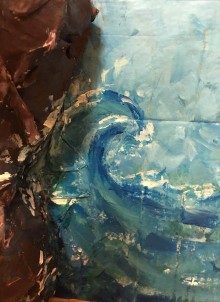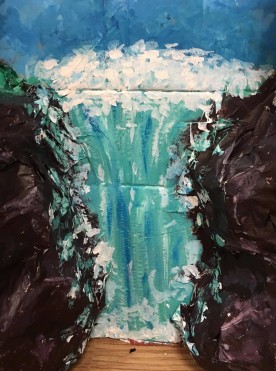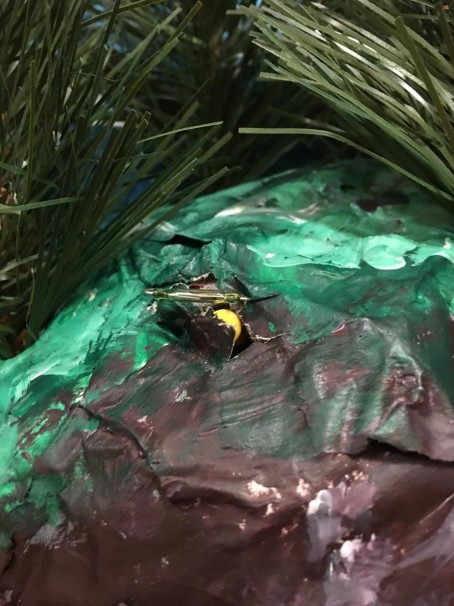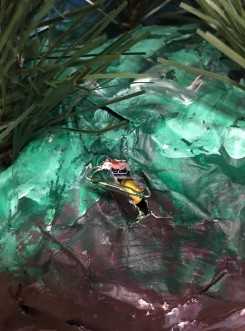FINAL PROJECT
THE IDEA
A BRIEF SUMMARY:
A 'board' of a visual landscape and a figure which can be attached to the board, once the figure is attached to the board - completing the circuit - there will be sound feedback to the user.
THE POINT:
- This can then be the basis for storytelling, it can be a 'prompt' for narratives, it can enhance narrative storytelling also by setting a scene with sound which is something that is never really touched upon in storytelling, this addresses the lack of acknowledgement of sound to create a story and set an atmosphere.
- It can also be used for learning. Children can learn sounds relative to imagery and what corresponds to different areas.
- It can also be a sound board for relaxation, for example, many people like to hear waves crashing or a river flowing to aid relaxation, or for people doing a yoga class or somebody having a massage. It would allow somebody to select where they want to be transported to visually and physically and then they receive the sound feedback.
This project of a knitted pig which plays a song according to what wig is connected to it via the metal poppers highlights one way i could connect my figure to the landscape.
Artist: Becky Stewart
CONNECTING THE FIGURE TO THE BOARD
1.
2.
METAL POPPERS
REED SENSOR MODULE
Using a reed sensor module would allow the figure to connect via magnetism which would in turn trigger the playback of sound dependant on which module the figure is placed.
DEVELOPMENT
V.1
V.2
V.3- FINAL
PROTOTYPE NO.1
A very basic prototype used to convey my idea.
Made form layers of cardboard to build up a three dimensional texture and from linen fabric painted to create the waterfall ripples with securing pins to hold the foreground onto the backing of the sheet of cardboard.
A figure made from card and wool with a magnet attached to the back. There are certain magnetic points on the cardboard landscape board where the magnetic will attach. This is an example of how the final piece will work, figure is placed in a select area = sound feedback.
A more thorough prototype in terms of visuals.
This uses cardboard, torn and layered. Wool, painted. Acetate, painted.
This depicts a scene offering a number of sound feedback opportunities.
Attachment points could be near the sea, the trees, the waterfall, the sky.
Building the final piece, modelling it around the prototypes. Larger scale, using boxes to build the basic structure
Then newspaper and packing paper scrunched up to create the textured surface.
Then paper-mache' to keep the structure. This allows the texture to stay but remains lightweight, and will allow easy integration of the arduino and reed sensors.
You can see the textured surface has remained with the varying levels.
This code was found on www.arduino.cc and was part of a tutorial on how to use a button in order to trigger an on and off state for an LED.
This code can be used for my project, instead of a button being the trigger for the LED firstly i want to make a 'reed sensor module' the trigger for the LED on and off state.
(click here)
Source:
Managing to get a magnet to trigger the LED on and off state using a reed sensor.
Code taken from video on youtube
(click here)
The next step is to get the reed sensor to now trigger sound. This requires the integration of a speaker into the circuit, and using tutorials which show sound being triggered by a button. Then i can adapt and swap the code so that it means the reed sensor replaces the function of the button
(click here)
Circuit diagram taken from an Instructables tutorial on how to get Arduino to play a 'wave' file, because my sound is not a melody using tones as it is prerecorded.
RESEARCH
SIMILAR CONCEPT - DIGITAL
This concept "The Infinite Adventure" is on a similar level to what i aim to explore with my own project. The app works as a prompt for story telling, and it depicts a scene visually.
My project will also be used as a prompt and a scene setter but with audio feedback and with the physical interaction of placing the character rather than the digital interaction that we see here.
I think this is an interesting comparison between similar concepts on a basic level, conducted in two opposite directions, digital and physical environments.
In basic terms, where the switches are in this diagram on the breadboard i will replace these with reed sensor modules. They wont be connected to the breadboard like these buttons, but in theory it will be very similar. The reed sensors will then be used to trigger a '1 or 0' (boolean) response depending on if the magnet is detected by a sensor or not. If a magnet is detected that will inform the Arduino to play the relative sound to which sensor was triggered.
Source:
The 8Ω (ohm) speaker i purchased i tested however it seemed to struggle with playing the audio clearly. So, i figured out it was because the connection to the jumper wires was loose and the wires moved around causing interference and lack of clarity.
To resolve this i will be soldering the jumper wires to the speaker to ensure no movement and in turn, clearer sound.
RETURN TO HOME
PROTOTYPE NO.2
"REACH" PROJECT
Source:
(click here)
Reach is a large-scale interactive mural and musical instrument created for the Children’s Museum of Pittsburgh as part of the Tough Art residency program. There are no visible electronics, but when users touch both the moon and a star (either alone or by holding hands with others) a tone is played.
"
"
This project caught my attention due to some similarities between its execution and my aim for my project. The whole way this works is from a board which gives sound feedback when one touches the moon and then a star at the same time. This is how the circuit is completed, and once completed the sound is generated to create a melody.
The presentation of a 'board-like' platform with 'access points' is exactly what i had in mind, it makes it interactive and physical which encourages engagement. I think this project is really insightful, and although on a larger scale to what i have in mind it has helped solidify the vision i have for my final project.
Like my own work will
become; it's ultimately,
interactive art.
(click here)
Source:
DEVELOPMENT
CONT.
Stages of development of the physical aspect of the project. Painting the scenery.
I used a christmas wreath to create the forest, giving it a more realistic presence than painting alone.
After finishing with the painting and the application of the forestry this is the final physical 'board'.
The areas which provoke the use of sound are;
the waterfall
the sea
the trees (birds calling)
cave
I plan to use royalty free stock sounds from online. I tried to record my own sounds however the quality wasn't high enough to justify using them and the better option was to use these downloaded sound effects. Below see the links to the used sounds, from 'freesound.org', the sounds have been merged and shortened to be approximately 7 second long clips for the project (see below).
sound 1
sound 2
sound 3
sound 4
This is the arduino playing a .wav audio file- i achieved this by using the following tutorial from instructables and the downloadable files:
After adapting the code by using the following instructables tutorial:
I then used a single reed sensor module to simulate all four sensors by changing the input pin to trigger the sound playback of each four different sounds.
You can see in this video that this works, the use of pin 8, 7, 6 and 5 trigger a different sound, as this works, when the other three sensor modules are connected to their correct input pins each sensor will then trigger its own unique sound.
click here
click here
click here
click here
Although this worked (above), when connecting the other three reed sensor modules to the arduino (so four in total) for a reason I cannot figure out and is beyond me after a long while trying to understand why, I cannot get them to function. The sounds will not play, when all the sensor modules are connected, even though it works with one sensor module connected and moving between input pins.
Because I cannot seem to solve this issue I have regrettably had to modify the final outcome.
I can only seem to achieve the playback of one sound, so the landscape board will only have one actively working sound as I can only get one reed sensor module to trigger a sound at a time.
As you can see above, the video illustrates how it does work with the code but seeing as it theoretically should have worked, when connecting the extra sensors I was unable to achieve full functionality.
Having identified that I am unable to get all four sensor modules to work in unison, I have implemented the single reed sensor into the board by cutting a hole in the back and feeding it through on a pen and poking it out of a small incision on the front of the board, it is then wired to the arduino which is in a box on the back of the board, and off of this is also the speaker which fits into a hole I cut behind the forestry section of the board. See below the images to illustrate this;
I have also developed a character board, two deer heads with magnets inside (in order to trigger the reed sensor module) have been implanted into a small board, you can pull out the heads to remove them from the board, there's a simple set of instructions also depicted on this small board which simply advise a user what they need to do.
A video of both magnetic deer heads being used to trigger the sensor within the landscape board.
I am happy with the appearance of the outcome however I am disappointed in the fact that it doesn't function as originally intended.
The aim is to act as a scene setter/ story prompt, using sounds as an intensifier for imagery which is something rarely experimented with books or physical objects. I wanted to create a newer dimension and include a sensory engagement not often experimented with in this context. It also acts a little like a 'game' which is interesting but was not my primary aim in the ideation behind this project.
I mentioned previously it could be for children to learn sound coordinating to the source, i feel my final product isn't aimed at children in particular, i feel it has a broader audience, the character set i created isn't specifically 'childlike' in any way and i feel it creates a slightly more sophisticated interaction. Something on a similar level with more engaging scenery for a child such as 'candy floss mountains and strawberry lace trees' with rainbow colours and extravagant sounds would be more appealing to a young audience I feel.




(instructables tutorial click here)
(instructables tutorial click here)
Here to the right you can see a yellow pen sticking out of a hole in the back of the board, to the other end of this pen the reed sensor module is fixed to give it stability and direction inside the model.
At the top centre the speaker is wired through a hole in the back of the board with the wires feeding down into the cardboard box which holds the arduino.
Powered by a 9v battery pack.
You can see other holes in the back of the board where the extra sensor modules would have been placed (although not all are visible in this image).
THE BACK OF THE BOARD
(THE FRONT)
(THE BACK)
The speaker embedded in the board behind the forestry so that it is not visible.
Schematic diagram of the circuit board illustrating a reed sensor triggering an LED, like the video to the left.
(From 123 Circuits).
A video the deer heads being used to trigger the sensor within the landscape board.
THE WIRING UP OF THE BOARD
CHARACTERS
THE FINISHED PROJECT
REFLECTION